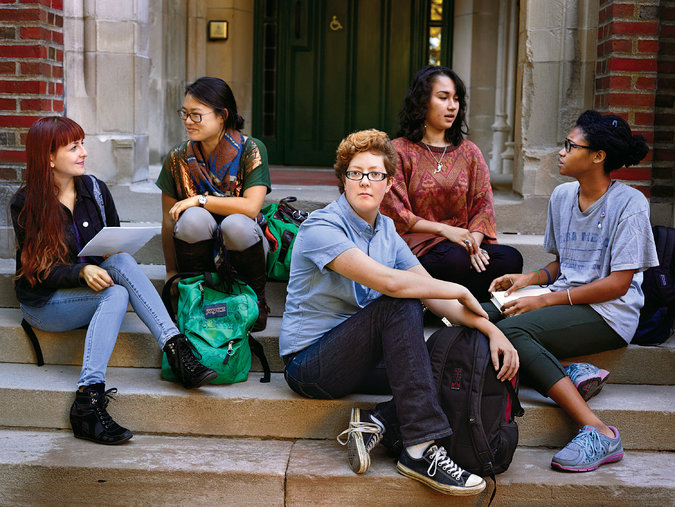As a follower of gender politics, I find this article fascinating. It is interesting to see this whole “gender” thing crumble under its own weight.
I am a Howard University graduate. A HISTORICALLY “black” university. That isn’t the case anymore. All kinds of people attend that school. Yes, it is majority brown skinned student body and majority female, but they are not denying an Asian kid or Indian girl from attending.
What happens when my son wants to attend Wellesley? He is certainly all male, but what if he identifies as female at age 17 when he applies to college?
Why can’t a man go to Wellesley?
Radicals at these colleges have taken over. Maybe it is time for people to stop being so damn afraid to speak up and show people how the real world works. There are limits to everything. People who scream for diversity and intolerance are chasing their tail.
Do they keep this as a “women’s school?’
Will men be able to attend because of gender diversity and full equality?
How can they deny anyone from attending? At what point do people say enough?
Will there really be “equality” between the sexes after all or will some sexes be more equal than others?
It was the first day of orientation, and along the picturesque paths there were cheerful upper-class student leaders providing directions and encouragement. They wore pink T-shirts stamped with this year’s orientation theme: “Free to Explore” — an enticement that could be interpreted myriad ways, perhaps far more than the college intended. One of those T-shirted helpers was a junior named Timothy Boatwright. Like every other matriculating student at Wellesley, which is just west of Boston, Timothy was raised a girl and checked “female” when he applied. Though he had told his high-school friends that he was transgender, he did not reveal that on his application, in part because his mother helped him with it, and he didn’t want her to know. Besides, he told me, “it seemed awkward to write an application essay for a women’s college on why you were not a woman.” Like many trans students, he chose a women’s college because it seemed safer physically and psychologically.
From the start, Timothy introduced himself as “masculine-of-center genderqueer.” He asked everyone at Wellesley to use male pronouns and the name Timothy, which he’d chosen for himself.
For the most part, everyone respected his request. After all, he wasn’t the only trans student on campus. Some two dozen other matriculating students at Wellesley don’t identify as women. Of those, a half-dozen or so were trans men, people born female who identified as men, some of whom had begun taking testosterone to change their bodies. The rest said they were transgender or genderqueer, rejecting the idea of gender entirely or identifying somewhere between female and male; many, like Timothy, called themselves transmasculine. Though his gender identity differed from that of most of his classmates, he generally felt comfortable at his new school.
Last spring, as a sophomore, Timothy decided to run for a seat on the student-government cabinet, the highest position that an openly trans student had ever sought at Wellesley. The post he sought was multicultural affairs coordinator, or “MAC,” responsible for promoting “a culture of diversity” among students and staff and faculty members. Along with Timothy, three women of color indicated their intent to run for the seat. But when they dropped out for various unrelated reasons before the race really began, he was alone on the ballot. An anonymous lobbying effort began on Facebook, pushing students to vote “abstain.” Enough “abstains” would deny Timothy the minimum number of votes Wellesley required, forcing a new election for the seat and providing an opportunity for other candidates to come forward. The “Campaign to Abstain” argument was simple: Of all the people at a multiethnic women’s college who could hold the school’s “diversity” seat, the least fitting one was a white man.
“It wasn’t about Timothy,” the student behind the Abstain campaign told me. “I thought he’d do a perfectly fine job, but it just felt inappropriate to have a white man there. It’s not just about that position either. Having men in elected leadership positions undermines the idea of this being a place where women are the leaders.”
I asked Timothy what he thought about that argument, as we sat on a bench overlooking the tranquil lake on campus during orientation. He pointed out that he has important contributions to make to the MAC position. After all, at Wellesley, masculine-of-center students are cultural minorities; by numbers alone, they’re about as minor as a minority can be. And yet Timothy said he felt conflicted about taking a leadership spot. “The patriarchy is alive and well,” he said. “I don’t want to perpetuate it.”
Read the rest HERE: http://www.nytimes.com/2014/10/19/magazine/when-women-become-men-at-wellesley-college.html?_r=0

